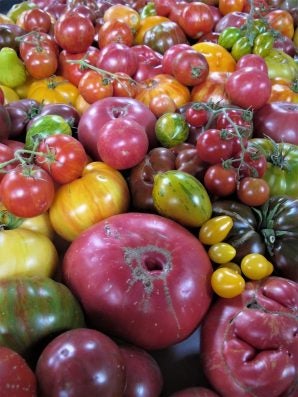The best time to pick tomatoes
Published 1:00 pm Sunday, July 17, 2022
|
Getting your Trinity Audio player ready...
|
Unlike a dog, only admitting to doing wrong after being dragged out from under the bed, I am the type of garden expert who quickly adapts recommendations based on new, solid, research-based new information. Even when it contradicts something I’ve been adamantly wrong about for decades.
Turns out, I have been backwards on the best time to pick tomatoes. So here goes with the egg-wiping from my face.
I already knew the difference between “climacteric” and “anti-climacteric” fruits, which indicates whether or not they continue to ripen or mature after being harvested.
Non-climacteric fruits are as ripe or mature as they will ever get the instant you pick them. Strawberries, blackberries, squash, melons, eggplant, pepper, and citrus fruits are like this come to mind; after harvest they simply start to decay. On the other hand, climacteric fruits, including bananas, figs, plums, peaches, avocadoes, and tomatoes, emit a lot of natural ethylene as the fruit matures, even after harvest, which helps them continue to ripen and develop color, flavor, and aroma.
For this reason, tomatoes, bananas, and avocados can be picked a little on the green side, when they are still firm enough to be shipped without bruising, and later exposed to ethylene gas to speed up their ripening. Grocery store suppliers do this all the time.
The reasons many store-bought tomatoes don’t taste like the home-grown tomatoes of our youth are based partly on varieties (most commercial kinds were bred for uniformity and ability to be shipped a long way and stored a long time, not for flavor), and partly on whether they were picked too soon, before they had a chance to fully develop maximum sugars and acids. And partly because our tastes change as we get older; as a psychologist member of the Mississippi Gardening FaceBook group put it, “Memories of what they used to taste like may have altered – perception and memory can be very wibbly-wobbly.”
This brings me to where I have been wrong for decades. I used to insist that, once picked off the vine, tomatoes do not continue to ripen and get more flavorful, they only get softer and colorful. Best to leave them on the vine until fully ripe. Turns out this is wrong, horticulturally, physiologically, and nutritionally.
Truth is, once tomatoes start to show a fair amount of pink color on that little “star” flare on the bottom, they contain all the natural sugars and nutrients they will ever get. Once that watery gel around the seeds starts to form, and the fruits start to get mushy, they are overripe and will start to decay quickly.
My ego screams for me to argue with this. But after digging into the research and chatting with Gary Bachman (MSU’s home garden specialist), I am convinced. Changing my recommendation.
So…unless you just like soggy sandwiches or eating tomatoes over the sink with juice running down your chin, pick tomatoes at the early or mid-pink stage, and store them in a cool place indoors (out of the sun and not in the fridge), stem side down to conserve moisture. They will color up to red, yellow, purple, striped, or whatever they are supposed to be, and be as flavorful and nutritious as “vine ripened” fruits, with less risk of sunscald, fruit splitting, damage from stinkbugs, birds, squirrels, and fungal decay. And last longer. And keep vines producing more.
Recommendations should adjust to dependable new information; minds and actions can, too. Live and learn, eh?
Felder Rushing is a Mississippi author, columnist, and host of the “Gestalt Gardener” on MPB Think Radio. Email gardening questions to rushingfelder@yahoo.com.






